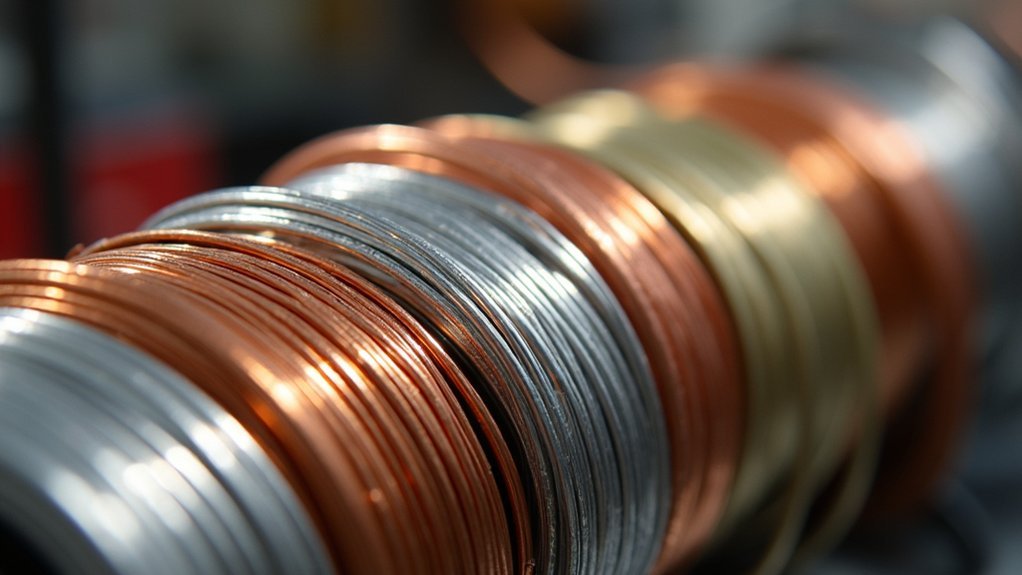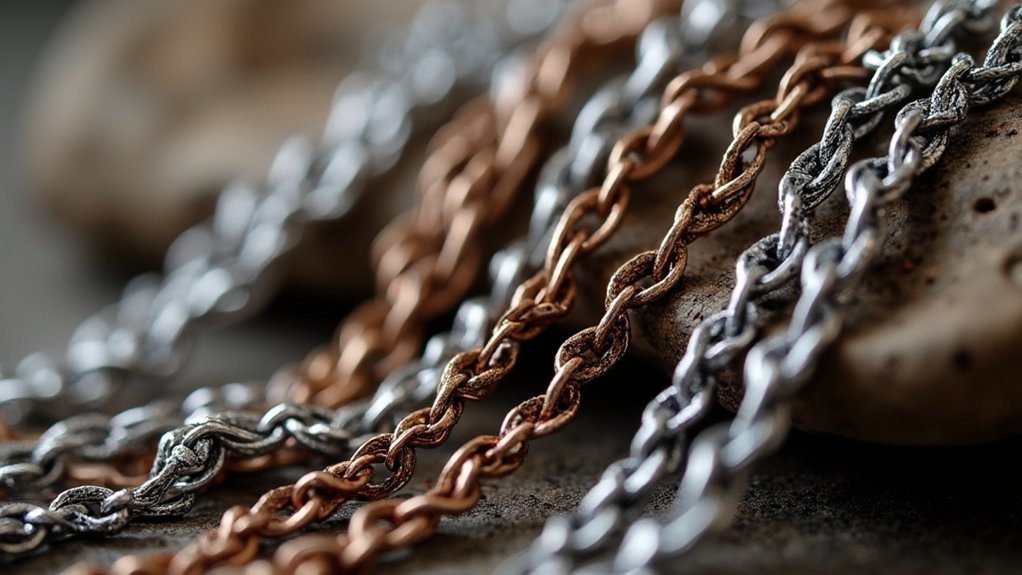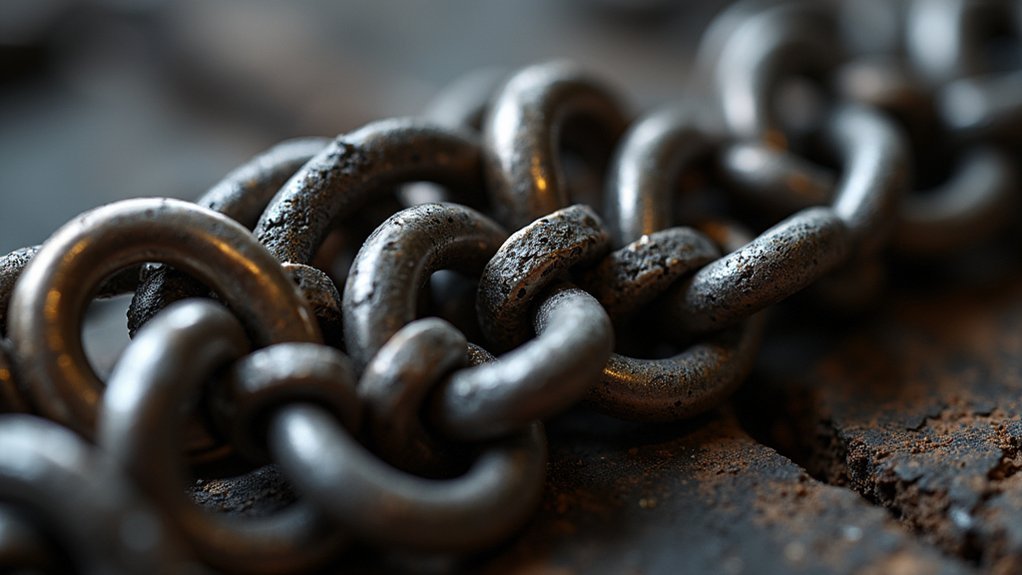You’ll need different wire gauges for different wirewrapping functions, with 20-22 gauge serving as your structural foundation, 24-26 gauge handling detailed binding work, and 28-30 gauge creating delicate finishing touches. Choose 20-gauge for most standard bead sizes, while 26-28 gauge works best for tiny bead openings. Half-hard wire provides strength for frameworks, while dead soft wire offers flexibility for intricate details. Understanding these fundamentals will transform your wirewrapping technique completely.
Understanding Wire Gauge Numbers and Measurements

Wire gauge numbers work backwards from what you’d expect—the higher the number, the thinner the wire becomes. In the American Wire Gauge system commonly used in the U.S. and Canada, 20-gauge wire has a wire diameter of 0.032 inches, while 30-gauge measures only 0.010 inches.
This AWG system includes 39 sizes based on a geometric formula where each gauge size decreases as numbers increase.
For wire wrapping projects, you’ll typically work with gauges ranging from 16-gauge for structural components to 28-gauge for delicate details.
Understanding these measurements is essential for jewelry making success. Thicker gauges provide strength and durability, while thinner wires allow intricate designs and flexibility in your wirework.
Essential Wire Gauges for Wirewrapping Projects
Now that you understand how wire measurements work, selecting the right gauges for your specific project needs becomes your next step. For wire wrapping success, you’ll need different gauges serving specific functions in your designs.
| Wire Gauge | Temper | Primary Use |
|---|---|---|
| 16-20-gauge | Half-hard wire | Structural components and frameworks |
| 22-26-gauge | Dead soft wire | General wrapping and medium details |
| 28-30-gauge | Dead soft wire | Fine lashing and intricate detailing |
Your heaviest wires, 16-gauge through 20-gauge, create strong foundations and frames that maintain shape. These structural components form your project’s backbone. Meanwhile, finer gauges from 26-gauge to 30-gauge excel at wrapping around larger wires, adding delicate details without bulk. Dead soft wire works best for smaller gauges since it’s easier to manipulate into precise shapes and intricate patterns.
20-22 Gauge Wire: The Wirewrapper’s Workhorse

You’ll find 22-gauge wire serves as the backbone of most wirewrapping projects, offering the perfect balance between workability and strength for countless applications.
Its structural properties make it ideal for creating secure frameworks while remaining flexible enough for intricate decorative elements like spirals and loops.
If you’re just starting your wirewrapping journey, this gauge provides the forgiving nature you need to master fundamental techniques without fighting overly thick or fragile wire.
Versatility and Common Applications
When exploring the world of wire wrapping, 22-gauge wire emerges as the undisputed champion for most projects. You’ll find this versatile wire adapts seamlessly to various bead sizes, from delicate pearls to substantial gemstone cabochons. Its balanced thickness lets you create secure connections without overwhelming your design’s aesthetic.
The common applications for 22-gauge wire span across multiple techniques. You’ll use it for crafting headpins that hold beads securely, forming ear wires that maintain their shape, and creating connecting links between heavier gauge framework wires.
When making pendants or small sculptural elements, you’ll appreciate how it holds intricate details while remaining workable.
For beginners entering wire wrapping, this gauge offers the perfect learning curve—thick enough for stability yet manageable enough to master fundamental techniques without frustration.
Structural Framework Properties
Beyond these everyday applications, 22-gauge wire’s structural support properties make it the backbone of complex wire-wrapped jewelry designs. You’ll find this dead soft wire creates reliable frameworks while maintaining enough flexibility for intricate shapes. Its 0.0280-inch diameter provides ideal structural support without overwhelming delicate components.
| Property | 22-Gauge Performance | Design Impact |
|---|---|---|
| Flexibility | High maneuverability | Enables complex curves |
| Strength | Maintains form under stress | Secure component attachment |
| Compatibility | Fits standard bead holes | Versatile application range |
When you’re creating delicate wire-wrapped links, 22-gauge wire delivers the perfect balance between workability and durability. You can manipulate it into sophisticated wire-wrapping techniques while ensuring your finished pieces won’t lose their shape over time.
Beginner-Friendly Wire Choice
Since you’re starting your wire-wrapping journey, 22-gauge wire offers the perfect entry point into this rewarding craft. This beginner-friendly option measures 0.0280 inches in diameter and strikes an ideal balance between being flexible and strong.
You’ll find it works seamlessly with most bead sizes, letting you create everything from delicate pieces to substantial designs.
What makes 22 gauge wire exceptional for jewelry-making is its forgiving nature. You can practice essential techniques like looping, wrapping, and creating jump rings without fighting stubborn material. The wire manipulates easily in your hands, reducing frustration while you’re learning.
Despite its beginner-friendly qualities, this versatile wire helps you achieve a professional look in your creations. You won’t need specialized tools or extensive experience to produce impressive wire wrapping results.
24-26 Gauge Wire for Detailed Work and Binding

Precision becomes paramount when you’re working on intricate jewelry designs that demand fine detail and minimal bulk. 26 gauge wire offers the perfect solution for detailed work, with its 0.0180-inch diameter providing exceptional control without overwhelming your design.
This wire gauge excels in wire wrapping applications where delicate loops and precise connections matter most. You’ll find 26 gauge wire particularly effective for binding beads together in rosary-style links, creating secure connections that maintain the jewelry’s elegant appearance.
Always choose dead soft temper for this gauge—it enhances flexibility and makes manipulation considerably easier during complex wrapping techniques. Handle this wire carefully, as its thinness makes it prone to breaking under excessive force.
With proper technique, you’ll achieve professional-looking results in your most demanding projects.
18 Gauge Wire for Structural Components and Frames
Foundation work requires wire gauges that won’t compromise under pressure or lose their intended shape over time.
Strong wire gauges form the backbone of any wire wrapping project, maintaining structural integrity under stress and preventing unwanted deformation.
For structural components in wire wrapping, you’ll want to use 16-gauge and 18-gauge wires as your backbone. These thicker gauges provide the necessary strength and shape retention that larger designs demand.
You should choose 16-gauge half-hard wire for your main structural elements, as it maintains rigidity while supporting intricate patterns. The 20-gauge wire also works well for sturdy frames, giving you flexibility to attach finer gauge wires for detailed work.
Remember that larger gauges like 16ga and 18ga serve as your core wires, while you’ll use dead soft wire for wrapping around these thicker structural components, ensuring easier manipulation without breakage.
Fine Gauge Wire (28-32) for Intricate Weaving

You’ll find that 28-32 gauge wire excels at creating delicate textures through intricate weaving patterns that add visual depth to your wirework pieces.
This fine wire becomes essential when you’re securing thicker structural elements, as it can wrap tightly around frame wires without adding bulk or disrupting your design’s flow.
The thin diameter allows you to weave complex patterns between structural components while maintaining the flexibility needed for detailed finishing work.
Delicate Texture Creation Techniques
When you’re working with fine gauge wire ranging from 28 to 32, you’ll discover incredible possibilities for creating delicate textures that transform ordinary wire wrapping into sophisticated artistry.
These ultra-thin wires excel at lashing beads together with precision, allowing you to secure smaller-holed beads that thicker gauges simply can’t accommodate. You can weave intricate patterns that add visual depth and complexity to your jewelry pieces.
However, you’ll need to handle these wires carefully since they’re prone to breaking when kinked or overmanipulated. Focus on gentle, controlled movements when creating fine coils or detailed wrapping techniques.
The 0.0148-inch diameter of 28 gauge wire provides an excellent starting point for beginners developing their delicate texture skills.
Securing Structural Wire Elements
Three fundamental principles govern how fine gauge wire transforms from delicate material into reliable structural support: proper tension control, strategic anchor points, and consistent wrapping direction.
When you’re securing structural wires with 28-32 gauge material, you’ll create secure connections that don’t compromise your design’s aesthetics. Dead soft wire becomes your ally here, bending easily around thicker framework elements while maintaining consistent pressure.
You’ll find fine gauge wire excels at lashing together multiple structural wires simultaneously, weaving intricate patterns that both strengthen and beautify your piece.
Focus on overlapping your wraps by fifty percent to guarantee maximum holding power. This wire wrapping technique transforms individual components into unified structures, allowing you to build complex frameworks that support heavier elements while showcasing delicate craftsmanship throughout your finished work.
Wire Hardness: Dead Soft Vs Half Hard for Wrapping
Beyond selecting the right gauge, wire hardness plays an essential role in determining your project’s success. Dead soft wire excels in intricate wire wrapping because it’s highly malleable, easily conforming around stones and beads. However, you’ll need to handle it carefully to prevent kinking or breaking. Half hard wire retains its shape better after bending, making it perfect for structural components that require strength and support.
| Wire Type | Best Use | Handling |
|---|---|---|
| Dead Soft | Delicate details | Gentle touch |
| Half Hard | Strong structure | Firm pressure |
| Combined | Professional finish | Balanced technique |
For contemporary wire projects, combine 16 gauge number half hard wire for structure with 22 gauge number dead soft wire for lashing and detailing. This combination dramatically impacts your piece’s aesthetics and durability.
Choosing Wire Gauge Based on Bead Hole Sizes

Since bead hole diameter directly determines which wire gauge you can use, measuring your beads before starting any project saves time and prevents frustration.
You’ll find that 20-gauge wire works well for most standard bead sizes, offering versatility and structural integrity for various designs.
When working with smaller holes, 24-gauge wire provides the perfect balance of flexibility and strength for intricate wrapping techniques.
For extremely delicate beads with tiny openings, consider 26-gauge wire or even 28-gauge for maximum finesse without damaging your materials.
Conversely, larger holed beads accommodate thicker options like 18-gauge or 16-gauge wire, which you can use to create robust structural elements.
Always match your wire gauge to bead hole size for ideal results and design success.
Wire Gauge Selection for Different Wirework Styles
While bead hole size determines your wire gauge options, your chosen wirework style ultimately dictates which gauges you’ll reach for most often.
For contemporary wire wrapping, you’ll want 16-gauge, 18-gauge, and 20-gauge wires as your structural foundation. These larger gauges provide the strength needed for framework components.
Smaller gauge wires like 26-gauge and 28-gauge excel at lashing elements together and creating detailed accents.
Fine-gauge wires transform into the perfect tools for binding components and adding intricate decorative details to your wirework.
Heady wire wrapping projects demand broader wire gauge selection, ranging from delicate 30-gauge to sturdy 16-gauge wires. This variety enables unique coiled textures and intricate artistic designs.
Choose half-hard wire for your 16-gauge and 18-gauge structural elements to maintain shape retention.
Select dead soft wire for 22-gauge through 30-gauge applications, ensuring maximum flexibility for detailed manipulation and sculpting work.
Common Wire Gauge Mistakes and How to Avoid Them
Even experienced wire artists fall into predictable gauge traps that compromise their finished pieces.
You’ll sabotage delicate wire-wrapping projects by choosing wire that’s too thick—stick with 20-24 gauge for ideal flexibility and clean aesthetics.
Don’t underestimate lashing requirements either; thin 30-gauge wire breaks easily, so use 22-26 gauge for structural integrity.
Many crafters wrongly assume all same-gauge wires perform identically, but wire hardness dramatically affects manipulation.
Dead soft behaves completely differently than half-hard wire. You must also match bead hole sizes carefully—28-gauge threads through tiny holes while 20-gauge suits larger openings.
Gauge conversion between AWG and SWG systems trips up many artists.
Remember: 20-gauge AWG measures thicker than 20-gauge SWG, so verify your measurement system to avoid these common mistakes.
Wire Gauge Compatibility With Tools and Techniques
Beyond choosing the right gauge, you’ll need properly matched tools to execute your wire-wrapping vision effectively. Your wire gauge directly determines which tools will work best for your project.
For ideal wire wrapping results, match these tools with appropriate gauges:
- Chain-nose and round-nose pliers – Work perfectly with 20ga to 26ga wire for loops and manipulation
- Flush wire cutters – Essential for clean cuts on finer wires (26ga and above) without fraying
- Standard cutters – Handle thicker gauges (16ga-18ga) that require more cutting power
- Specialized pliers – Needed for half-hard larger gauges versus dead soft smaller wires
Remember that 16ga and 18ga half-hard wires need stronger tools, while 22ga to 30ga dead soft wires require gentler handling to prevent damage during wire wrapping.
Building Your Wire Gauge Collection: What to Buy First
Since you understand which tools work with different gauges, you can strategically build a wire collection that maximizes your project possibilities without overwhelming your budget.
Start with essential Wire Gauge sizes: 16, 18, and 20 gauge wires for versatile jewelry making techniques and structural elements.
Essential wire gauges 16, 18, and 20 form the foundation for most jewelry making projects and structural work.
Add 22 and 24 gauge wires for lashing and delicate details that fit through most gemstone beads.
Consider 26 and 28 gauge wires for finest applications like wire crocheting and securing small beads.
Make certain you have both dead soft and half hard options—dead soft excels at wrapping and sculpting, while half hard provides shape retention.
Build your inventory with sterling silver wire and copper wire for quality and affordability.
Frequently Asked Questions
What Gauge of Wire for Wire Wrapping?
You’ll want 16-20 gauge wire for your main structural work, providing strength and flexibility. Use 22-30 gauge for decorative details and lashing. Choose half-hard for frames, dead soft for finer manipulation.
What Is the Best Wire for Beginner Wire Wrapping?
You’ll want 20-gauge wire for your first wire wrapping projects. It’s sturdy enough to hold shapes but manageable for beginners. Choose dead soft temper since it bends easily while you’re learning manipulation techniques.
What Wire Is Used for Wire Wrapping Stones?
You’ll use 16-20 gauge wire for structural frames holding stones securely, while 22-24 gauge works best for wrapping and decorative elements. Choose dead soft wire for easier manipulation around your stones.
What Is 20 Gauge Beading Wire Used For?
You’ll use 20 gauge beading wire for creating sturdy chains, wrapping beads, making loops, and crafting ear wires. It’s perfect for structural elements, clasps, and jump rings while maintaining flexibility.
In Summary
You’ll master wirewrapping by starting with 20-22 gauge wire for most projects, then adding 24-26 gauge for detail work and 18 gauge for structural elements. Don’t buy every gauge at once—build your collection based on your preferred styles and projects. Remember that wire gauge affects both your technique and final results, so you’ll want to match the right gauge to each specific application for professional-looking wirewrap jewelry.





Leave a Reply